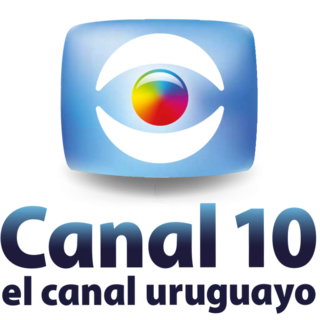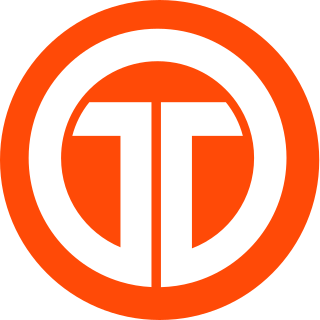
Televisión Española is Spain's national state-owned public television broadcaster and the oldest regular television service in the country. It was also the first regular television service in Equatorial Guinea.

Televisión Nacional de Chile (TVN) is a Chilean public service broadcaster. It was founded by order of President Eduardo Frei Montalva and it was launched nationwide on 18 September 1969. Since then, the company has been reorganized on several occasions and its operations areas have increased over the years, becoming one of the leading television broadcasters in Chile and South America. Law 17 377 of 1970 established that TVN must be a public, autonomous, pluralistic, and representative public service. TVN's public mission determines the obligation to promote the national cultural identity, the values of democracy, human rights, care for the environment and respect for diversity. Furthermore, Televisión Nacional governs the programming of its services according to criteria established by the National Television Council (CNTV).

La 2 is a Spanish free-to-air television channel owned and operated by Televisión Española (TVE), the television division of state-owned public broadcaster Radiotelevisión Española (RTVE). It is the corporation's second television channel, and is known for broadcasting cultural and public service programming, including documentaries, concerts, theatre and independent, Ibero-American and classic cinema.

Telecinco is a Spanish free-to-air television channel operated by Mediaset España. The channel was previously known as Tele 5, because it had first begun its experimental transmissions on 10 March 1989, and a year later, it was officially launched on 3 March, 1990, becoming the fifth of the national terrestrial television channels and the second private channel in Spain. In 1997, Tele 5 was rebranded as Telecinco, dropping the biscione-absent flower logo seen in other Mediaset channel logos.

TVI - initialism for Televisão Independente - is Portugal's fourth terrestrial television channel, launched in 1993. It was the most watched channel in Portugal from 2005 to 2019 and since March 2024 the channel was most viewed preferred. It competes directly with SIC and RTP1. It is one of the two private free-to-air channels in Portugal, among the seven terrestrial free-to-air channels broadcasting from the country.
UNITEL is a Bolivian commercial television network headquartered in Santa Cruz de la Sierra, Bolivia. It was founded in 1987 in Santa Cruz de la Sierra as Teleoriente, which in 1997 created the current network and bought two Telesistema Boliviano stations. It is owned by businessman Osvaldo Monasterio Nieme. The company broadcasts sports, entertainment, political programs, and daily news programs nationwide in the South American country.

Mega is a Chilean television network owned by Mega Media, a Bethiaholding company. It began its transmissions on 23 October 1990 as the first private television network in the country on channel 9 in Santiago, replacing Señal 2 of Televisión Nacional de Chile. The station is a member of the Asociación Nacional de Televisión and Organización de Telecomunicaciónes de Iberoamérica, and is part of the Alianza Informativa Latinoamericana

Bolivisión is a commercial Bolivian television station based in Santa Cruz. The channel was launched on June 17, 1997, following the dissolution of Telesistema Boliviano, the creation of Unitel and the beginning of its relations with Galavisión in Santa Cruz. The network is owned by Albavisión since May 2007.

Channel 10 is a Uruguayan free-to-air television network based in Montevideo. It began its transmission in 1956 as the first television broadcaster in the country and the fourth in Latin America. Its owned and operated by Sociedad Anónima Emisora de Emisión Televisión y Anexos. The network's headquarters are in the Palermo neighbourhood.
Television in Spain was introduced in 1956, when the national state-owned public service television broadcaster Televisión Española (TVE) started regular analog free-to-air terrestrial black and white broadcasts. Colour transmissions started in 1972 after two years of test transmissions, with all programming transmitted in color in 1977, and colour commercials starting in 1978. TVE held a monopoly on television broadcasting until regional public channels were launched during the 1980s and commercial television started nationwide in 1990. Digital terrestrial television was launched on 30 November 2005 with analog service discontinued on 3 April 2010. Currently, television is one of the leading mass media of the country, and by 2008 was in 99.7% of households in Spain according to INE statistics.

Televisión Boliviana is the first television channel of Bolivia and serves the only means of television communication from the government. The channel was established in August 1969 under the government of Luis Adolfo Siles after years of planning by the government of then-recently deceased René Barrientos. It is a state-owned broadcasting network.
Television in Latin America currently includes more than 1,500 television stations and more than 60 million TV sets throughout the 20 countries that constitute Latin America. Due to economic and political problems television networks in some countries of this region have developed less than the North American and European networks, for instance. In other countries like Colombia or Chile, television broadcasting has historically been public-broadcast dominated until the 1990s. The largest commercial television groups are Mexico-based Televisa, Brazil-based Globo and Canada-based Canwest Latin American Group. Due to the shared language of Spanish by two thirds of Latin Americans a lot of programmes and broadcasters operate throughout the region, offering both United States television and Spanish-language television.
Television in Peru has a history of more than 60 years. There are 105 television broadcasters in Peru, 22 of which are in Lima. In regard to television receivers, in 2003 there were 5,470,000 — that is 200 televisions for every thousand inhabitants. The number of cable subscribers was 967,943 in 2011.

Telemetro is a television network headquartered in Panama City, Panama, with repeaters throughout the country. The station broadcasts in NTSC format and in Panama City also in DVB-T format. In 1996 Telemetro and RPC TV merged and formed Corporacion Medcom.

Sistema Nacional de Televisión, sometimes simply known as SNT, is a Paraguayan television network which reaches almost the entire population of Paraguay. SNT coverage almost all the Región Oriental, where approximately 97% of the population of Paraguay lives. Currently it has 11 repeaters.
Antena 21 is a Spanish-language broadcast television station in Santo Domingo, Dominican Republic on UHF channel 21. It's owned by Albavision. It was founded in 1968 as Noticias 24 Horas. The station currently airs general entertainment programming.

Global Televisión, is a television network owned by Grupo ATV that transmits to all of Peru. It was founded in 1986 and is one of the six networks with national coverage.

Canal 12 is a Salvadoran television station owned by Red Salvadoreña de Medios. The station was founded by Jorge Emilio Zedán on 15 December 1984. Since its affiliation to the Albavisión media network, its greatest success has been the strengthening of its information system and the transmission of international sports content.

Carolina Ferre Amat is a Spanish journalist who has developed her career mainly in television.

C9N is a Paraguayan over-the-air news network owned by Remigio Ángel González's Albavisión conglomerate. It was an independent station from 2013 to 2017 and before, an affiliate of SNT with selected local programming.















